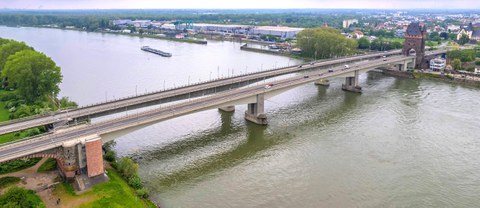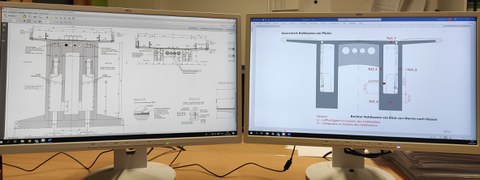Design methodology for cross-life structural health monitoring
Table of contents
Project data
| Titel | Title Entwurfsmethodik für ein lebensdauerübergreifendes Bauwerksmonitoring bei unbekanntem Schadensprozess | Design methodology for cross-life structural health monitoring with unknown damage process Förderer | Funding Deutsche Forschungsgemeinschaft (DFG) / SPP 2388 Zeitraum | Period 08/2022 – 02/2026 Projektleiter | Project manager Prof. Dr.-Ing. Steffen Marx Team | Team Dipl.-Ing. Cedric Eisermann, Dr.-Ing. Chongjie Kang, Jan-Hauke Bartels, M.Sc. |
Report from year book 2023
Monitoring concepts for bridges without damage

The historic Nibelungen Bridge Worms is the validation structure of SPP 2388
The aim of our project in the Priority Program 2388 (SPP 2388) is the development of a design methodology that allows the design of monitoring concepts for bridges with unknown damage mechanisms. In the first funding phase, the focus is on the physical structure and physical parameters that need to be monitored to identify potential damages. The work program includes two interacting approaches: a cluster-based approach and an object-based approach.
Within the cluster-based approach, it is investigated whether and how clusters for prestressed concrete bridges can be formed based on filterable features in bridge management systems. To achieve this, the totality of filterable features is initially reduced, based on literature, to a delimited number of damage-relevant features. Subsequently, the inventory of prestressed concrete bridges is clustered using unsupervised learning. For one specific cluster, characteristic damage processes are identified based on structure records and inspection reports, and physical parameters for their monitoring are defined. Since the validation of the methods developed in SPP 2388 is carried out on the cantilever-constructed Nibelungenbrücke, this step primarily involves the analysis of cantilever-constructed bridges. A representative sample of prestressed concrete and cantilever-constructed bridges has already been identified.
The object-related approach is based on the analysis of the specific structure. For this purpose, the typical assessment methods for existing structures, inspection and recalculation, are placed in the context of future metrological monitoring. For the Nibelungen Bridge, a comprehensive structural diagnosis has already been carried out using the existing inspection reports, whereby the reinforcement and tendon corrosion as well as the shear force bearing capacity were identified as decisive weak points. In addition, a numerical model of the Nibelungen Bridge was developed. The initial numerical investigations show good agreement between the simulation results and the measurement data from the sensors installed on the structure.
Report from year book 2022
Bridge monitoring of the future – predictive instead of reactive

Planning of the sensor network for the Nibelungen Bridge in Worms
The topic of the Dresden subproject of the Priority Programme (SPP) 2388 “Hundred plus” is the development of a design methodology for cross-life bridge monitoring systems, which start to function with the construction and operation of the structure when no damage is normally present.
The current bridge maintenance strategy is characterized by scheduled periodic on-site inspections. Structures are inspected every three years for damage, which is then documented. This analogous process is work intensive and structural anomalies can only be detected and recorded only a discrete time basis. Any damage that may jeopardize the safety of the bridge that occurs between two inspections cannot be accounted for in time. Continuous detection in the form of bridge monitoring is able to remedy this situation. The objective of this sub-project is, therefore, to develop a methodology that can be used to develop a sensor concept for cross-life monitoring systems.
In the first funding phase, the research focus will be on the behavior of the physical structure and the corresponding values, which shall be measured with sensors. The working program of this project includes two interacting approaches. On the one hand, a cluster-based approach will be used to systematically evaluate existing bridges in terms of their most critical damages. On the other hand, an object-related approach will be applied. The structural behavior of a specific construction will be analyzed with regard to the physical values to be monitored. Both physically based finite element models and data-based models using machine learning methods are investigated regarding their suitability for developing sensor concepts. Both approaches will lead to new knowledge in the design method of a sensor network, which will be validated at the Nibelungen Bridge in Worms, Rhineland-Palatinate.
In collaboration with the coordination project of the SPP 2388 “Hundert plus”, the first sensor application sites for the Nibelungen Bridge have been defined. An initial structural health monitoring was tendered via the TU Dresden and subcontracted externally. This sensor concept will be successively developed and improved within the subproject.
